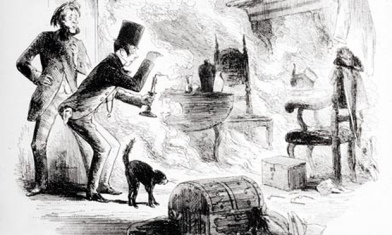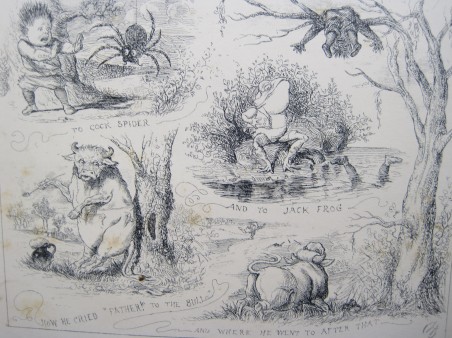What do you do when you want to evaluate if an article is a reliable, credible source of information? Purdue’s Online Writing Lab, my favorite wellspring of writing advice, counsels that “responsible, credible authors will cite their sources so that you can check the accuracy of and support for what they’ve written.” Sensible advice, in my opinion.
Bearing that in mind, let’s take a look at this July 1812 issue of The Emporium of Arts and Sciences (vol. 1, no. 3), which features some of the most fantastically impeccable science I have ever encountered in my short but highly scientific life.
The name sounds pretty legit, no? It even says “sciences” in the title!

How reliable is the author? Does he cite his sources so that we can examine the support for what he’s written?

Ooo, yes, plenty of (poorly photographed) footnotes, and some of them are even in French! This author does his homework, and he’s bilingual, to boot. I’m leaning towards deeming this a trustworthy source for information about…

“Combustion of the Human Body, produced by the long and immoderate use of Spirituous Liquors”.
Hang on, what? Drinking too much can make your body catch on fire? I’d consider that “destitute of probability”, as author Pierre-Aime Lair notes that some readers, myself apparently included, may be apt to consider. He promptly addresses our collective doubts:

Is it more surprising to experience such incineration than to void saccharine urine, or to see the bones softened to such a degree as to be reduced to the state of a jelly? The effects of this combustion are certainly not more wonderful than those of the bones softened, or of the diabetes mellitus.
Point taken– the human body can be strange and marvelous. I still want more proof, though.
In physics, facts being always preferable to reasoning, I shall here collect those which appear to me to bear the impression of truth; and, lest I should alter the sense, I shall quote them such as they are given in the works from which I have extracted them.
Oh good, facts! The author’s “facts” are henceforth presented in nine thoroughly footnoted pages of wildly gruesome recollections wherein women, in their drunkenness, were reduced to piles of ash, often with a few extremities preserved in near-perfect condition. It’s an awful lot to take in, and I’ll spare you the bulk of it, lest you be haunted by nightmares like the ones I’m sure to have tonight. Highlights include a woman whose maid found her as “a heap of ashes, in which could be distinguished the legs and arms untouched”, a room full of “a moist kind of soot” which was “conveyed to a neighbouring kitchen… a piece of bread in the cupboard was covered with it, and no dog would touch it”, a woman whose trunk had “the appearance of a log of wood”, and an ash pile next to an extremely small hearth with a “right foot… found entire, and scorched at its upper junction”.
So, that’s terrifying. For readers who are, no doubt, feeling overwhelmed by the sheer volume of this horrific evidence, the author sums up commonalities in a handy list:

1. The persons who experienced the effects of this combustion had for a long time made an immoderate use of spirituous liquors.
2. The combustion took place only in women.
3. These women were far advanced in life.
4. Their bodies did not take fire spontaneously, but were burnt by accident.
5. The extremities, such as the feet and the hands, were generally spared by the fire.
6. Water sometimes, instead of extinguishing the flames which proceeded from parts on fire, gave them more activity.
7. The fire did very little damage, and often even spared the combustible objects which were in contact with the human body at the moment when it was burning.
8. The combustion of these bodies left as a residuum fat foetid ashes, with an unctuous, stinking, and very penetrating soot.
All of my modern, feminist sensibilities are offended by the idea that this fate only befalls older women. Why do women have to bear the brunt of the ill effects of heavy drinking? How on earth do fiery accidents distinguish between male and female bodies in the first place? How does one become so deeply imbued with liquor that one’s body is essentially a figgy pudding?
Not to fear, Pierre-Aime Lair can explain.

The female body is generally more delicate than that of the other sex. The system of their solids is more relaxed; their fibres are more fragile and of a weaker structure, and therefore their texture more easily hurt. Their mode of life also contributes to increase the weakness of their organization. Women, abandoned in general to a sedentary life, charged with the care of the internal domestic economy, and often shut up in close apartments, where they are condemned to spend whole days without taking any exercise, are more subject than men to become corpulent. The texture of the soft parts in female bodies being more spongy, absorption ought to be freer; and as their whole bodies imbibe spirituous liquors with more ease, they ought to experience more readily the impression of fire.
Um. Women have weak fibers and are spongy. But why older women, specifically?

Dancing and walking, which form salutary recreation for young persons, are at a certain age interdicted as much by nature as by prejudice. It needs therefore excite no astonishment that old women, who are in general more corpulent and more addicted to drinking, and who are often motionless like inanimate masses, during the moment of intoxication, should experience the effects of combustion.
Older women are “spongy”, AND they’re “motionless like inanimate masses”?! They’re more likely to be drunk, and therefore more likely to light on fire while going about their daily business? This is amazing! This is impeccably scientific! Surely our female readers are now convinced not to imbibe in excess.
Does that mean that nothing bad ever happens to men who drink? Not the case, according to dear old Pierre-Aime. It’s just that men don’t burn in place, leaving behind forlorn hands and feet, but rather tend towards having flames shoot out of their bodies.

Sturmius says, that in the northern countries flames often burst from the stomach of persons in a state of intoxication. Three noblemen of Courland having laid a bet which of them could drink most spirits, two of them died in consequence of suffocation by the flames which issued with great violence from their stomachs. We are told by Thomas Bartholin, on the authority of Vorstius, that a soldier, who had drunk two glasses of spirits, died after an eruption of flames from his mouth.
There are the facts, folks. I’ll let them speak for themselves.


























